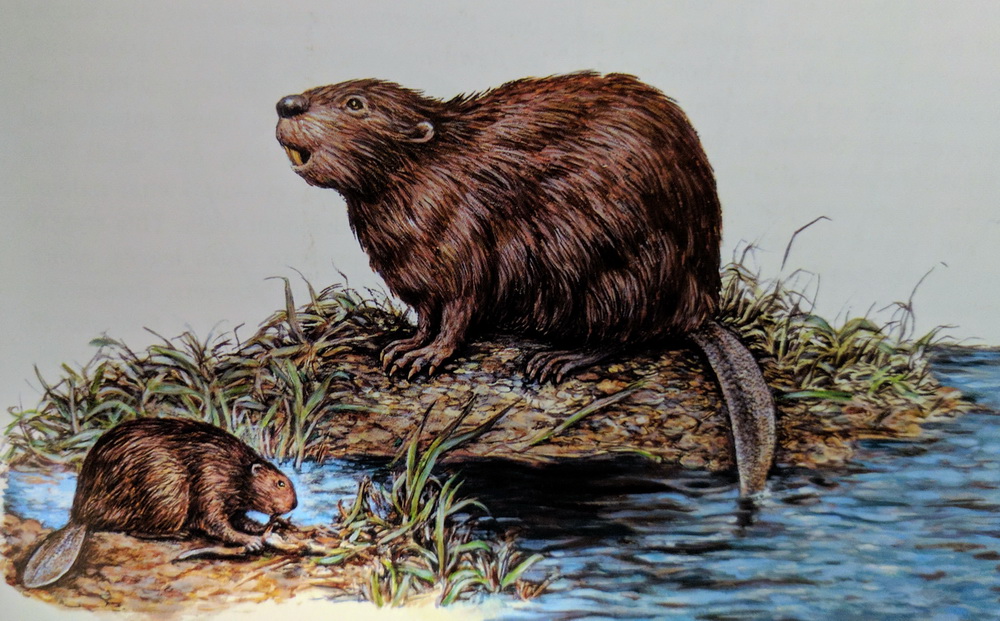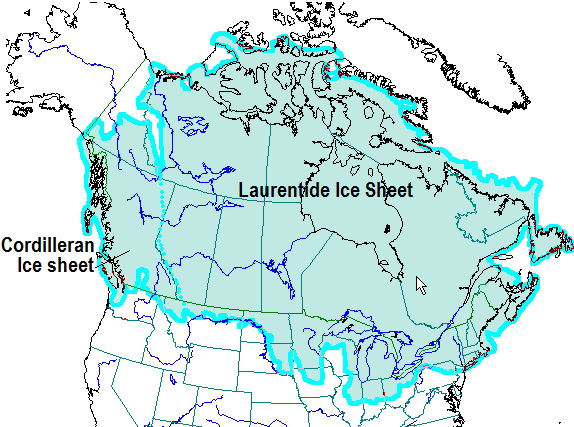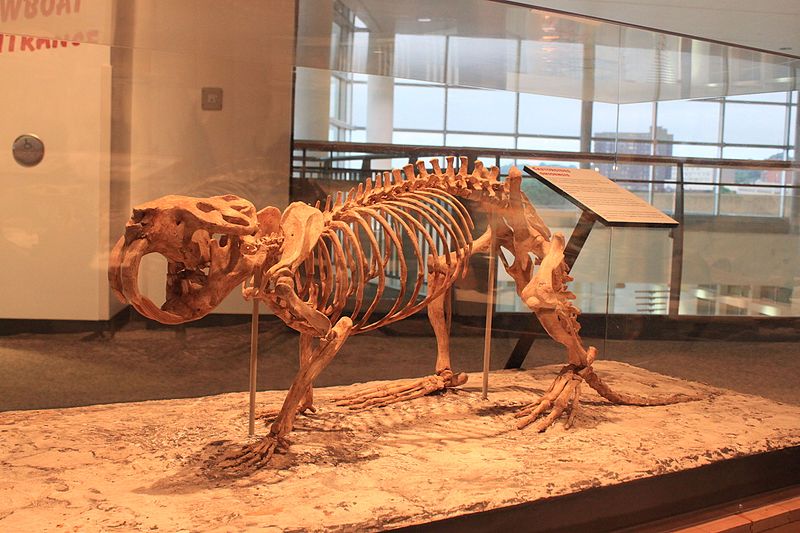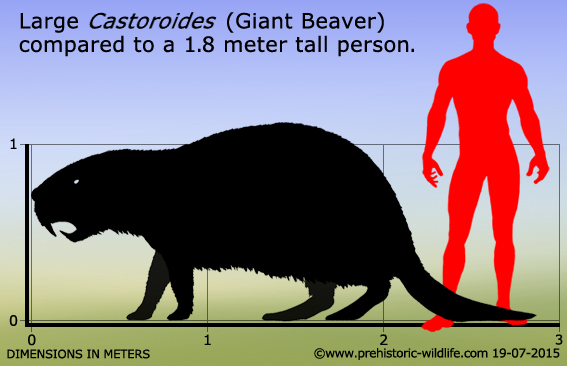Ice Age Mammals - The Giant Beaver (Castoroides ohioensis)
Figure 1: A cartoon illustration that compares the Giant Beaver (Castoroides ohioensis) on the top and the modern-day North American Beaver (Castor canadensis). Image from the book entitled Ice Age mammals of North America - A Guide to the Big, the Hairy, and the Bizarre, by Ian M. Lange and Illustrated by Dorothy S. Norton, Mountain Press Publishing Co, Montana, 2002, 226p.
Gigantic Beavers In Canada?
Wow! Would you believe it? Was there a beaver that once lived in Canada that was up to 2.2 meters (7 feet) long, stood stood about 1 m (3 feet) tall, and weighed as much as a black bear?
Well, the answer is yes! They existed here in Canada up to about 10,000 years ago. I am certain they would have been a sight to behold (Figure 1).
It is called the Giant Beaver and its scientific name is Castoroides ohioensis. The Giant Beaver is the largest beaver that we know about. It was the largest rodent to have ever lived on the North American continent. It is one of the giant animals, called megafauna, that lived in North America during, and immediately after, the last great ice age.
Recall that the last great ice started about 2,580,000 years ago and is still happening in parts of the world, like Antarctica, the Arctic, and many mountain areas. During the peak of the last stages of this glaciation, which lasted from about 125,000 to 12,000 years ago, almost all of Canada and ALL of Ontario was covered by ice that was as much as 2 to 3 km thick (Figure 2). In Ontario, the ice started to melt for the last time about 18,000 years ago and all of Ontario was free of ice by about 8,000 years ago.
Figure 2: This cartoon shows the coverage across North America of glacial ice during the peak of the last age, called the Wisconsin Glaciation, about 15,000 years ago. Image from: Physical Geology, Chapter 16.1, Glacial Periods in Earth’s History.
Fossil Remains Of The Giant Beaver
The Giant Beaver appears to have lived only in North America during this time of ice and dramatically different climate (Yukon Beringia).
In Canada, fossil remains of the Giant Beaver have been found only in three locations: a) Old Crow region, Yukon; b) Don Beds, Toronto, Ontario; and c) Indian Island, New Brunswick. Interestingly, fossils show that both the Giant Beaver (Castoroides ohioensis) and the modern North American Beaver (Castor canadensis) lived together near Old Crow, Yukon, during the last part of the ice age.
Many more fossil remains of the Giant Beaver (Figure 3) have been found in eastern United States, south of the Great Lakes, but not in the western United Sates (Yukon Beringia): Alabama: Florida, Georgia, Illinois, Iowa, Kansas, Michigan, Nebraska, New Jersey, Ohio, Oklahoma, Pennsylvania, South Carolina, Tennessee, and Virginia.
Figure 3: This image was originally photographed at the Minnesota Science Museum: Mississippi River Gallery and posted to Flickr by Ryan Somma at http://flickr.com/photos/14405058@N08/7322608522. Image granted Creative Commons Licensed photo by ideonexus.com and appears on wikimedia: https://commons.wikimedia.org/wiki/File:Giant_Pleistocene_Beaver,_Castoroides_ohioensis.jpg
Age Of Giant Beaver Fossils
Geologists measured the age of fossil remains of the Giant Beaver found in North America. The youngest Giant Beaver fossil is about 12,000 to 10,000 years old (Yukon Beringia). The oldest fossil remains are about 3 million years old. This means that the Giant Beaver went extinct sometime around, or slightly younger than 10,000 years ago.
How Big Was The Giant Beaver?
The largest individual Giant Beavers were up to 2.2 meters (7 feet) long, not including its tail (Figure 4). It stood about 1 m (3 feet) tall. This was as big as a modern black bear! The Giant Beaver could have weighed up to about 200 kg (440 pounds). Compare that to the modern beaver, which weighs up to about 30 kg (65 pounds).
Figure 4: A scaled cartoon showing the size of the largest Giant Beaver, relative to an adult human. Image from prehistoric-wildlife.com
Although the Giant Beaver looked like a very large version of the modern North American beaver, the Giant Beaver had a longer and narrower tail and had incisor teeth that were up to 15 cm long.
What Type Of Habitat Did The Giant Beaver Live In?
Based on the geology of the material that contains fossil remains of the Giant Beaver, it appears that the Giant Beaver preferred to live in lakes and ponds that were surrounded or boarded by swamps (Yukon Beringia), but with few trees (Seeker 2012).
What Did The Giant Beaver Eat?
The Giant Beaver was an herbivore. That means it ate vegetation. It did not eat meat. Scientists have measured certain chemical properties of the fossil teeth belonging to the Giant Beaver. This analysis suggests that the Giant Beaver was not a tree-cutting and tree-eating machine (Seeker 2012). The chemical analysis of teeth fossils suggests that the Giant Beaver preferred to eat aquatic plants, similar to today's muskrat (Yukon Beringia and Seeker 2012).
Did The Giant Beaver Build Dams and Lodges?
Some researchers suggest that it is not known if the Giant Beaver built dams and lodges like modern beavers, but we should remember that fossil remains of dams and lodges would be hard to preserve over thousands of years. Even if a structure like a dam or lodge were found as a fossil, it would be really hard to be certain it was made by the Giant Beaver as opposed to having been made by natural forces such as ancient floods.
Based on the design of their teeth, some researchers suggest the Giant Beaver did not chew down trees and did not build dams (Yukon Beringia). The teeth of the Giant Beaver do not appear well suited to cutting wood. Modern beavers have teeth that grow constantly and that are designed to cut through wood, unlike the teeth of the Giant Beaver. However, there is still debate.
Is The Giant Beaver Related To Modern Beaver?
The fossil bones of the Giant Beaver look a lot like those of a modern beaver, only much larger (Yukon Beringia). Are they both related? The Giant Beaver is an ancient ancestor of the modern modern beaver (Castor canadensis). But just how old is that ancestry? The fossil history suggests that the Giant Beaver and the modern beaver shared a common ancestor up to about 24 million years ago (Yukon Beringia). They followed separate evolutionary paths since then.
Why Did Giant Beaver Go Extinct?
There is debate about the cause of the extinction of the Giant Beaver.
During the last 100,000 years, about 36 genera of ice age mammals, or about 70% and 75% of all ice age mammals in North America, went extinct (J. Tyler Faith, 2011 and Ian M. Lange). You can think of the word "genera" to refer to a type of animal, like a dog. Within that genera of animal, like dogs, there are many different species of dog, such a Labrador retriever and Chihuahua.
Interestingly, the extinctions were greatest for the largest of the megafauna, larger than 1000 kg (Ian M. Lange) and over half the mammal genera that weighed between 32 and 1000 kg also went extinct (see the summary by J. Tyler Faith (2011). But, smaller mammals also went extinct. The bulk of these extinctions took place towards the end of the last great ice age, between 25,000 and 10,000 years ago (Yukon Beringia).
A complete and detailed discussion of all extinction theories is beyond the scope of this note; however, several ideas have been suggested to explain the extinctions of the ice age mammals towards the end of the ice age (see summary by Tyler Faith, 2011 and Ian M. Lange): a) climate change, such as the impact of periodic warm and very cold periods, toward the end of the ice age; b) change in nutritional quality, types, and range of vegetation eaten by megafauna in an area due to climate change and/or change in the soil nutrients; c) change in the geographic range of animal communities; d) increased burning of vegetation; e) the arrival of Clovis hunter - gatherers in North America, who would have hunted the megafauna to extinction; and f) a very controversial idea that extinction was caused by an extra-terrestrial impact event.
Specifically, regarding the Giant Beaver, there does not appear to be fossil evidence that it was hunted by people. Therefore, perhaps the Giant Beaver was not able to adapt to the changing climate and changing habitats that came with the periodic hot and cold periods at the end of the Ice Age. As plant types changed, and the soil nutrients changed, maybe the Giant Beaver just slowly ate all the food they needed to survive in an area and were not able to adapt to eating different plants. This led some researchers to suggest that perhaps the Giant Beaver starved to death (Tyler Faith, 2011) perhaps because the Giant Beavers could not compete with the other rodents, like modern beavers or muskrats (Yukon Beringia).
The mystery of the Giant Beaver extinction continues.
The Giant Beaver and Aboriginal Oral Tradition
I am not an expert on Aboriginal oral tradition, but I have been privileged to listen to some oral stories shared with me by my First Nation friends. I am struck by the parallels between the First Nation oral recounts of geological and other land-related understandings and my understanding of the land seen through my geological eyes.
Do stories of the Giant Beaver exist in Aboriginal oral tradition? If so, what do those oral accounts tell us about life with the Giant Beaver? Did First Nation ancestors encounter the Giant Beaver before it went extinct about 10,000 years ago. Perhaps the oral accounts imply that the Giant Beaver went extinct more recently. For many reasons, it is instructive to become familiar with these First Nation oral stories.
Here is a partial list of links to some Aboriginal oral stories and accounts about the Giant Beaver. I share these links with respect so that we may benefit from the lessons, insights, and geological and land-related references that are wrapped up in the Aboriginal oral traditions:
How Glooscap created sugarloaf Mountain: retold by Elder Margaret Labillois and Luke Simon of Big Cove.
Koluskap and the Giant Beaver: told by Gwen Bear.
The Collective Memory of the Prehistoric Past and the Archaeological Landscape: by Cynthia J. Wiley.
Maasu Re-creates the World: originally told by Job Kawapit of Whapamagoostui, a Cree Master Story Teller.
Chapter 2.3 Algonquin History in The Ottawa River Watershed, by James Morrison, Sicani Research and Advisory Services, in The Ottawa River Heritage Designation Project: search the text for "Giant Beaver". Section 2.3.1. (Algonquin Origins) includes the story "Wiskedjak Pursues the Beaver", told by Ben McKenzie, a member of the Kiwegoma Anishnabeg (or Dumoine) Band (now the Wolf Lake First Nation), contains several interesting parallels between the story and the geological history of eastern Ontario.
Yomazha Kills The Giant Beavers: A Dogrib First Nation Legend.
Stories From The Seventh Fire: search the text on Giant Beaver to locate the specific
The Giant Beaver Legend: Pocumtuck was the name of a now extinct tribe of First Nation people who lived in the southern New England area, USA, prior to 1800. According to stories ascribed to the tribe, Pocumtuck Ridge and Sugarloaf Mountain were the remains of a Giant Beaver killed by the giant spirit Hobomock.
The Giant Beaver: A Prehistoric Memory?: by Jane C. Beck This link reproduces the original article by Jane Beck that was published in Ethnohistory, Vol. 19, No. 2 (Spring, 1972), pp. 109-122.
Summary
North America was once the home of the ice mage mammal called the Giant Beaver (Castoroides ohioensis). It is one of the giant animals, called megafauna, that lived in North America during, and immediately after, the last great ice age. It was the largest rodent to have ever lived in North America. It was as big as a black bear. The Giant Beaver preferred to live in lakes and ponds and it was an aquatic plant-eater. It did cut or eat trees - or at least trees did not appear to make up a large part of its diet. It is not certain if the Giant Beaver built dams and lodges like modern beavers. The Giant Beaver is an ancient ancestor of the modern modern beaver (Castor canadensis). It appears that the Giant Beaver went extinct at the end of the last ice age, about 10,000 years ago.
Reference to the Giant Beaver appears in many Aboriginal oral traditional stories that reference the land. Many of these stories bear a similarity to geological understanding about the land.
So, the next time you walk over the land, think about the time during and following the last great ice age when the Giant Beaver also walked on the Ontario Beneath Our Feet!
Have A Question About This Note?
Andy Fyon, March 17, 2017; April 4/17; April 6/17.




